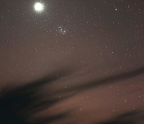Comets come in groups and pairs
Mar 04, 2020
3 minutes
by David Seargent
Last December, two interesting (but intrinsically faint) comets were found by the Asteroid Terrestrial-impact Last Alert System (ATLAS) in Hawaii. They are fascinating objects.
The first, officially designated was discovered on December 16 as a fuzzy speck of magnitude 18. As further observations were obtained, an orbit was calculated which revealed a remarkable similarity with those of comets C/1988 A1 (Liller), C/1996 Q1 (Tabur) and C/2015 F3 (SWAN). The new comet therefore becomes the fourth member of what has become known as the Liller Group. Like the famous Kreutz Group, these comets are
You’re reading a preview, subscribe to read more.
Start your free 30 days



